Cabramatta Ethnic Concentration: People, Place, and Social Difference
VerifiedAdded on 2020/03/16
|6
|1131
|274
Essay
AI Summary
This essay delves into the multifaceted aspects of ethnic residential concentration in Cabramatta, Australia, focusing on the Indo-Chinese-Australian community. It examines the benefits, such as cultural maintenance, social welfare support, economic development, and the provision of culturally specific services, including bilingual support in financial institutions and medical centers. The essay also addresses the challenges, including historical negative perceptions and potential social tensions. Through illustrative photographs, the essay highlights the transformation of Cabramatta into a vibrant center of cultural diversity and economic activity, showcasing how community leaders and the Australian government have worked to overcome negative stereotypes and foster a thriving multicultural environment. The analysis concludes that the benefits of ethnic concentration in Cabramatta outweigh the challenges, contributing to its economic, social, and cultural significance.
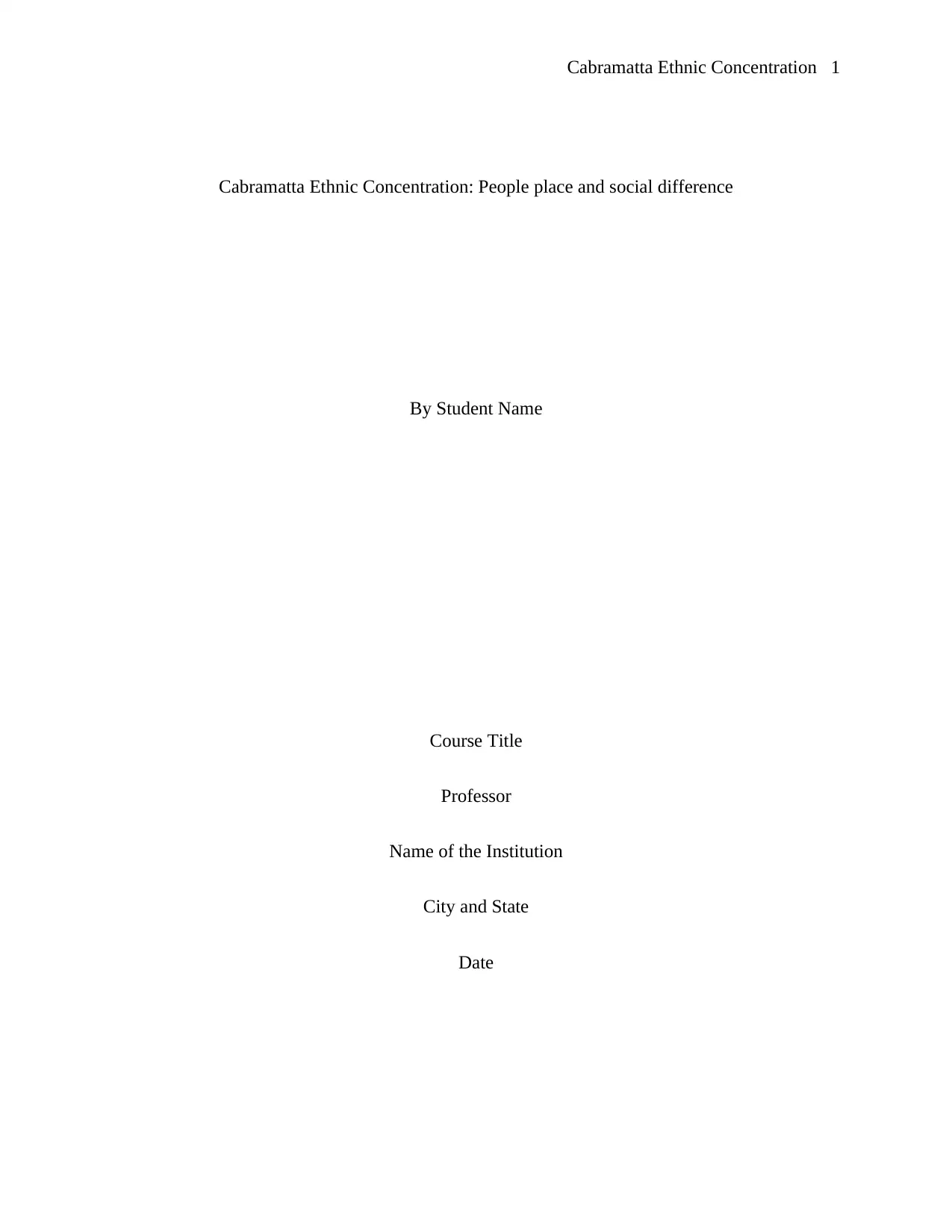
Cabramatta Ethnic Concentration 1
Cabramatta Ethnic Concentration: People place and social difference
By Student Name
Course Title
Professor
Name of the Institution
City and State
Date
Cabramatta Ethnic Concentration: People place and social difference
By Student Name
Course Title
Professor
Name of the Institution
City and State
Date
Paraphrase This Document
Need a fresh take? Get an instant paraphrase of this document with our AI Paraphraser
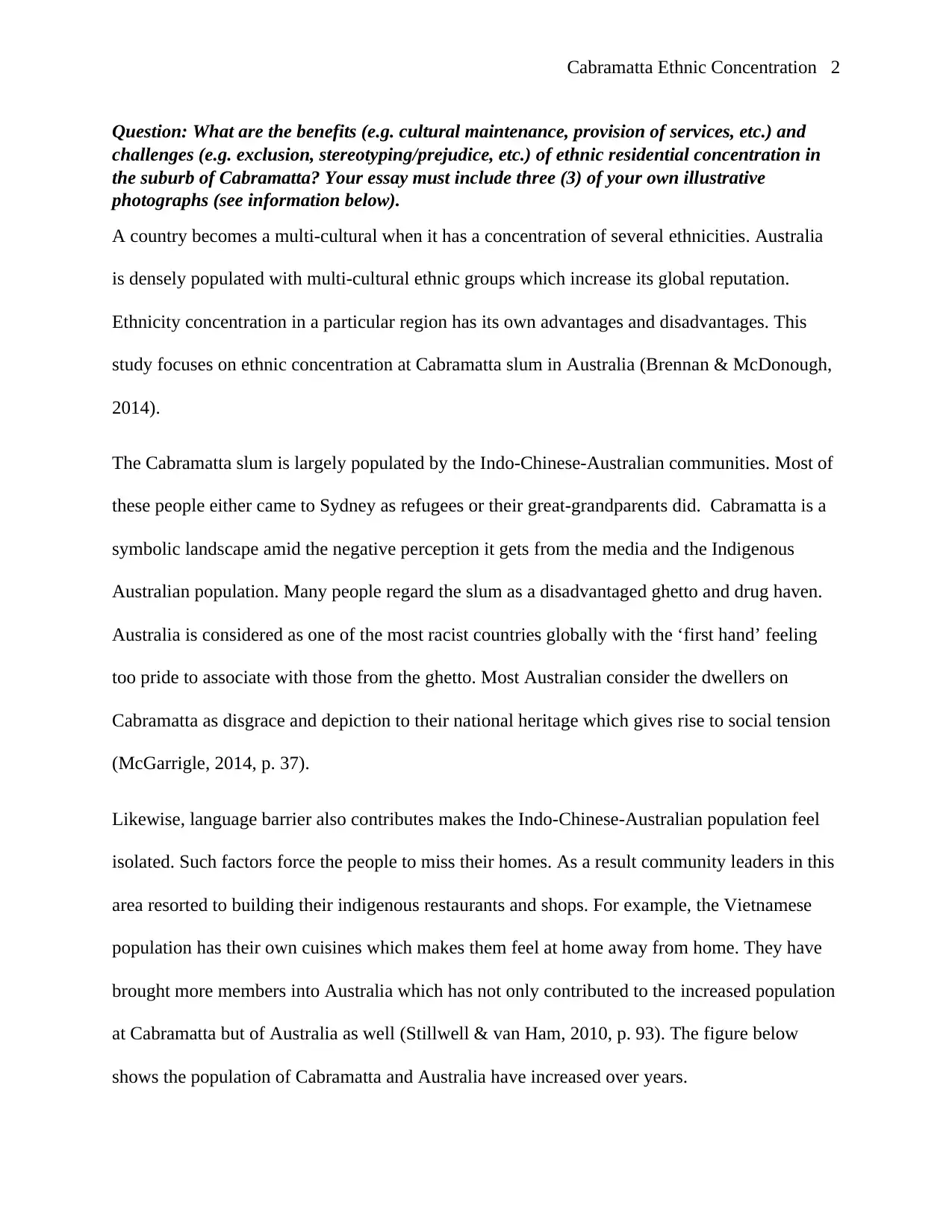
Cabramatta Ethnic Concentration 2
Question: What are the benefits (e.g. cultural maintenance, provision of services, etc.) and
challenges (e.g. exclusion, stereotyping/prejudice, etc.) of ethnic residential concentration in
the suburb of Cabramatta? Your essay must include three (3) of your own illustrative
photographs (see information below).
A country becomes a multi-cultural when it has a concentration of several ethnicities. Australia
is densely populated with multi-cultural ethnic groups which increase its global reputation.
Ethnicity concentration in a particular region has its own advantages and disadvantages. This
study focuses on ethnic concentration at Cabramatta slum in Australia (Brennan & McDonough,
2014).
The Cabramatta slum is largely populated by the Indo-Chinese-Australian communities. Most of
these people either came to Sydney as refugees or their great-grandparents did. Cabramatta is a
symbolic landscape amid the negative perception it gets from the media and the Indigenous
Australian population. Many people regard the slum as a disadvantaged ghetto and drug haven.
Australia is considered as one of the most racist countries globally with the ‘first hand’ feeling
too pride to associate with those from the ghetto. Most Australian consider the dwellers on
Cabramatta as disgrace and depiction to their national heritage which gives rise to social tension
(McGarrigle, 2014, p. 37).
Likewise, language barrier also contributes makes the Indo-Chinese-Australian population feel
isolated. Such factors force the people to miss their homes. As a result community leaders in this
area resorted to building their indigenous restaurants and shops. For example, the Vietnamese
population has their own cuisines which makes them feel at home away from home. They have
brought more members into Australia which has not only contributed to the increased population
at Cabramatta but of Australia as well (Stillwell & van Ham, 2010, p. 93). The figure below
shows the population of Cabramatta and Australia have increased over years.
Question: What are the benefits (e.g. cultural maintenance, provision of services, etc.) and
challenges (e.g. exclusion, stereotyping/prejudice, etc.) of ethnic residential concentration in
the suburb of Cabramatta? Your essay must include three (3) of your own illustrative
photographs (see information below).
A country becomes a multi-cultural when it has a concentration of several ethnicities. Australia
is densely populated with multi-cultural ethnic groups which increase its global reputation.
Ethnicity concentration in a particular region has its own advantages and disadvantages. This
study focuses on ethnic concentration at Cabramatta slum in Australia (Brennan & McDonough,
2014).
The Cabramatta slum is largely populated by the Indo-Chinese-Australian communities. Most of
these people either came to Sydney as refugees or their great-grandparents did. Cabramatta is a
symbolic landscape amid the negative perception it gets from the media and the Indigenous
Australian population. Many people regard the slum as a disadvantaged ghetto and drug haven.
Australia is considered as one of the most racist countries globally with the ‘first hand’ feeling
too pride to associate with those from the ghetto. Most Australian consider the dwellers on
Cabramatta as disgrace and depiction to their national heritage which gives rise to social tension
(McGarrigle, 2014, p. 37).
Likewise, language barrier also contributes makes the Indo-Chinese-Australian population feel
isolated. Such factors force the people to miss their homes. As a result community leaders in this
area resorted to building their indigenous restaurants and shops. For example, the Vietnamese
population has their own cuisines which makes them feel at home away from home. They have
brought more members into Australia which has not only contributed to the increased population
at Cabramatta but of Australia as well (Stillwell & van Ham, 2010, p. 93). The figure below
shows the population of Cabramatta and Australia have increased over years.
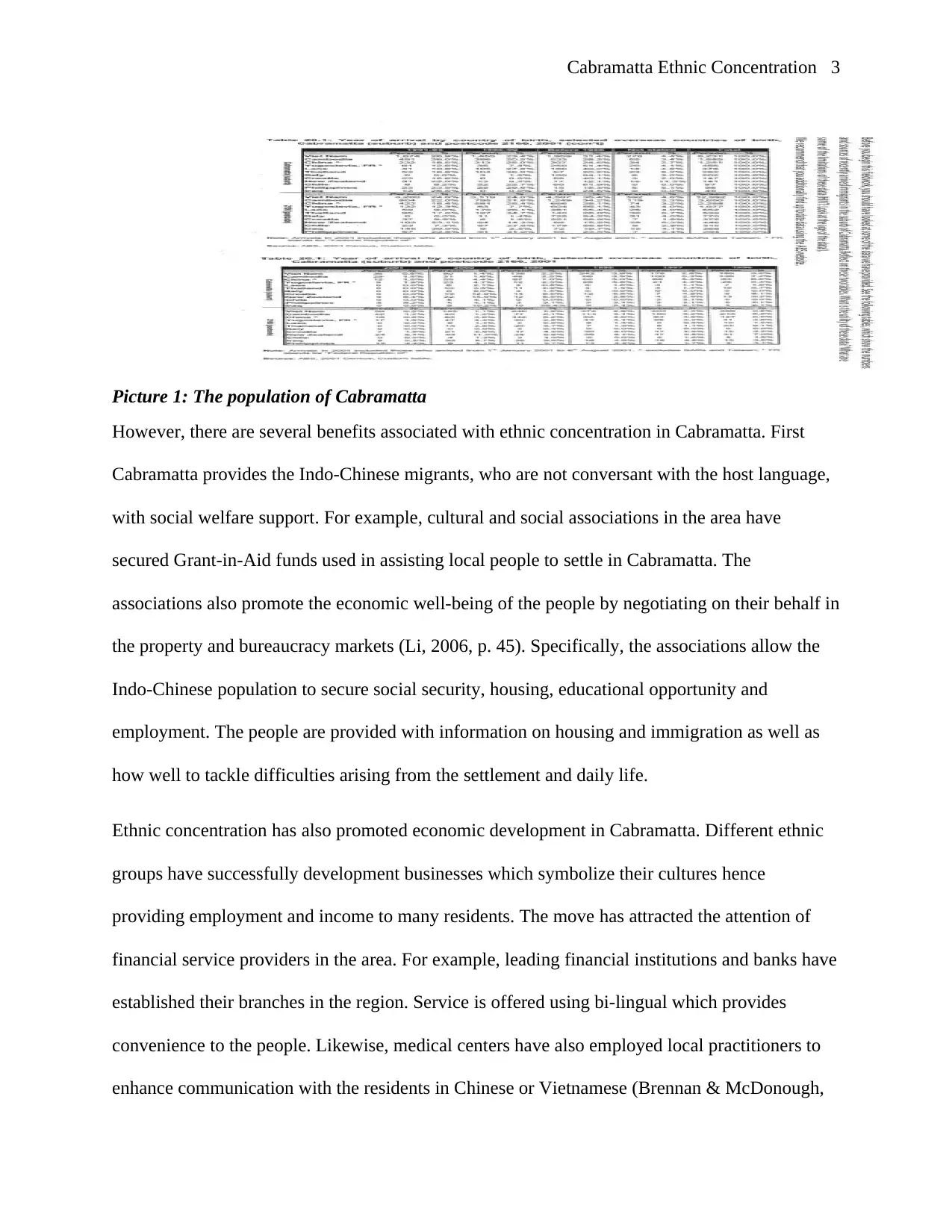
Cabramatta Ethnic Concentration 3
Picture 1: The population of Cabramatta
However, there are several benefits associated with ethnic concentration in Cabramatta. First
Cabramatta provides the Indo-Chinese migrants, who are not conversant with the host language,
with social welfare support. For example, cultural and social associations in the area have
secured Grant-in-Aid funds used in assisting local people to settle in Cabramatta. The
associations also promote the economic well-being of the people by negotiating on their behalf in
the property and bureaucracy markets (Li, 2006, p. 45). Specifically, the associations allow the
Indo-Chinese population to secure social security, housing, educational opportunity and
employment. The people are provided with information on housing and immigration as well as
how well to tackle difficulties arising from the settlement and daily life.
Ethnic concentration has also promoted economic development in Cabramatta. Different ethnic
groups have successfully development businesses which symbolize their cultures hence
providing employment and income to many residents. The move has attracted the attention of
financial service providers in the area. For example, leading financial institutions and banks have
established their branches in the region. Service is offered using bi-lingual which provides
convenience to the people. Likewise, medical centers have also employed local practitioners to
enhance communication with the residents in Chinese or Vietnamese (Brennan & McDonough,
Picture 1: The population of Cabramatta
However, there are several benefits associated with ethnic concentration in Cabramatta. First
Cabramatta provides the Indo-Chinese migrants, who are not conversant with the host language,
with social welfare support. For example, cultural and social associations in the area have
secured Grant-in-Aid funds used in assisting local people to settle in Cabramatta. The
associations also promote the economic well-being of the people by negotiating on their behalf in
the property and bureaucracy markets (Li, 2006, p. 45). Specifically, the associations allow the
Indo-Chinese population to secure social security, housing, educational opportunity and
employment. The people are provided with information on housing and immigration as well as
how well to tackle difficulties arising from the settlement and daily life.
Ethnic concentration has also promoted economic development in Cabramatta. Different ethnic
groups have successfully development businesses which symbolize their cultures hence
providing employment and income to many residents. The move has attracted the attention of
financial service providers in the area. For example, leading financial institutions and banks have
established their branches in the region. Service is offered using bi-lingual which provides
convenience to the people. Likewise, medical centers have also employed local practitioners to
enhance communication with the residents in Chinese or Vietnamese (Brennan & McDonough,
⊘ This is a preview!⊘
Do you want full access?
Subscribe today to unlock all pages.

Trusted by 1+ million students worldwide
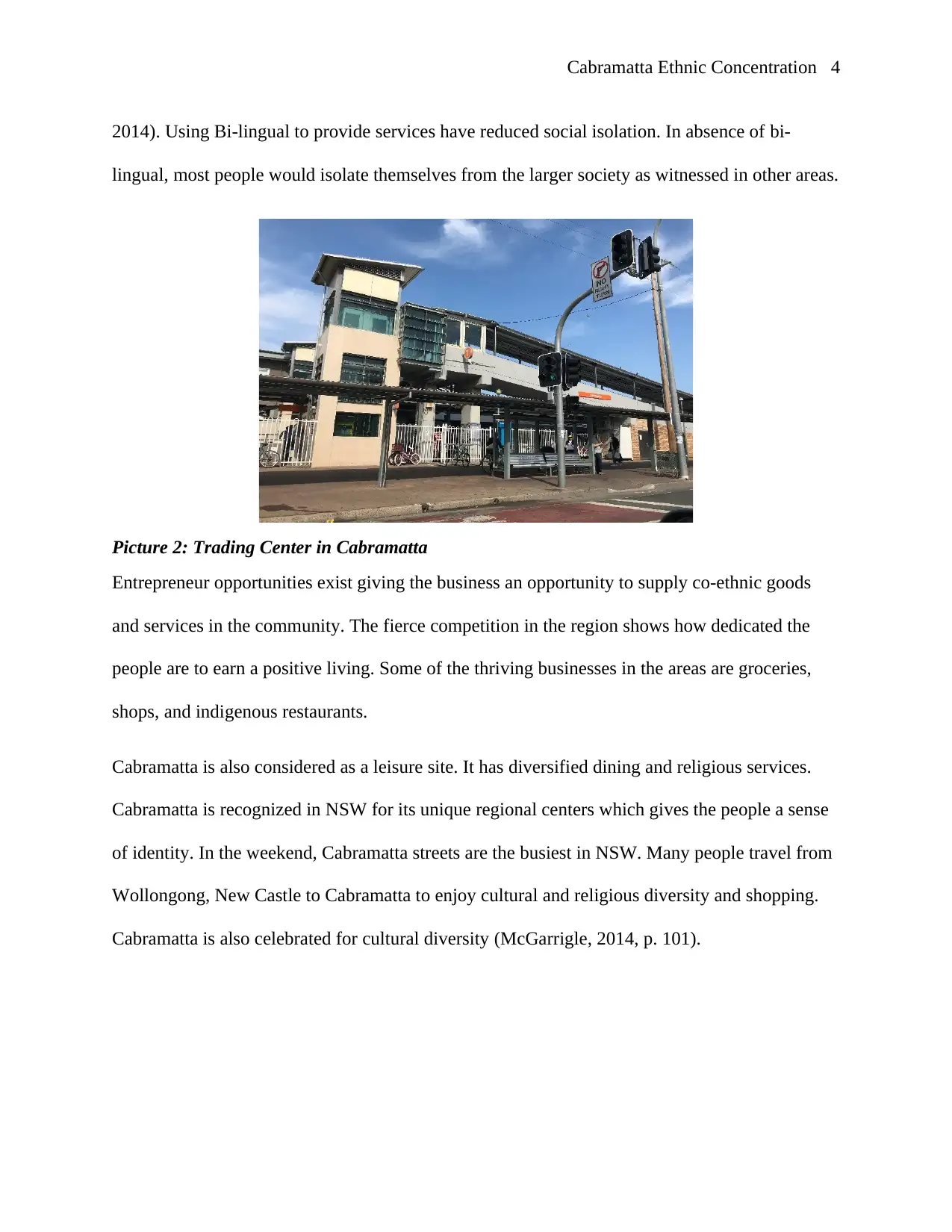
Cabramatta Ethnic Concentration 4
2014). Using Bi-lingual to provide services have reduced social isolation. In absence of bi-
lingual, most people would isolate themselves from the larger society as witnessed in other areas.
Picture 2: Trading Center in Cabramatta
Entrepreneur opportunities exist giving the business an opportunity to supply co-ethnic goods
and services in the community. The fierce competition in the region shows how dedicated the
people are to earn a positive living. Some of the thriving businesses in the areas are groceries,
shops, and indigenous restaurants.
Cabramatta is also considered as a leisure site. It has diversified dining and religious services.
Cabramatta is recognized in NSW for its unique regional centers which gives the people a sense
of identity. In the weekend, Cabramatta streets are the busiest in NSW. Many people travel from
Wollongong, New Castle to Cabramatta to enjoy cultural and religious diversity and shopping.
Cabramatta is also celebrated for cultural diversity (McGarrigle, 2014, p. 101).
2014). Using Bi-lingual to provide services have reduced social isolation. In absence of bi-
lingual, most people would isolate themselves from the larger society as witnessed in other areas.
Picture 2: Trading Center in Cabramatta
Entrepreneur opportunities exist giving the business an opportunity to supply co-ethnic goods
and services in the community. The fierce competition in the region shows how dedicated the
people are to earn a positive living. Some of the thriving businesses in the areas are groceries,
shops, and indigenous restaurants.
Cabramatta is also considered as a leisure site. It has diversified dining and religious services.
Cabramatta is recognized in NSW for its unique regional centers which gives the people a sense
of identity. In the weekend, Cabramatta streets are the busiest in NSW. Many people travel from
Wollongong, New Castle to Cabramatta to enjoy cultural and religious diversity and shopping.
Cabramatta is also celebrated for cultural diversity (McGarrigle, 2014, p. 101).
Paraphrase This Document
Need a fresh take? Get an instant paraphrase of this document with our AI Paraphraser
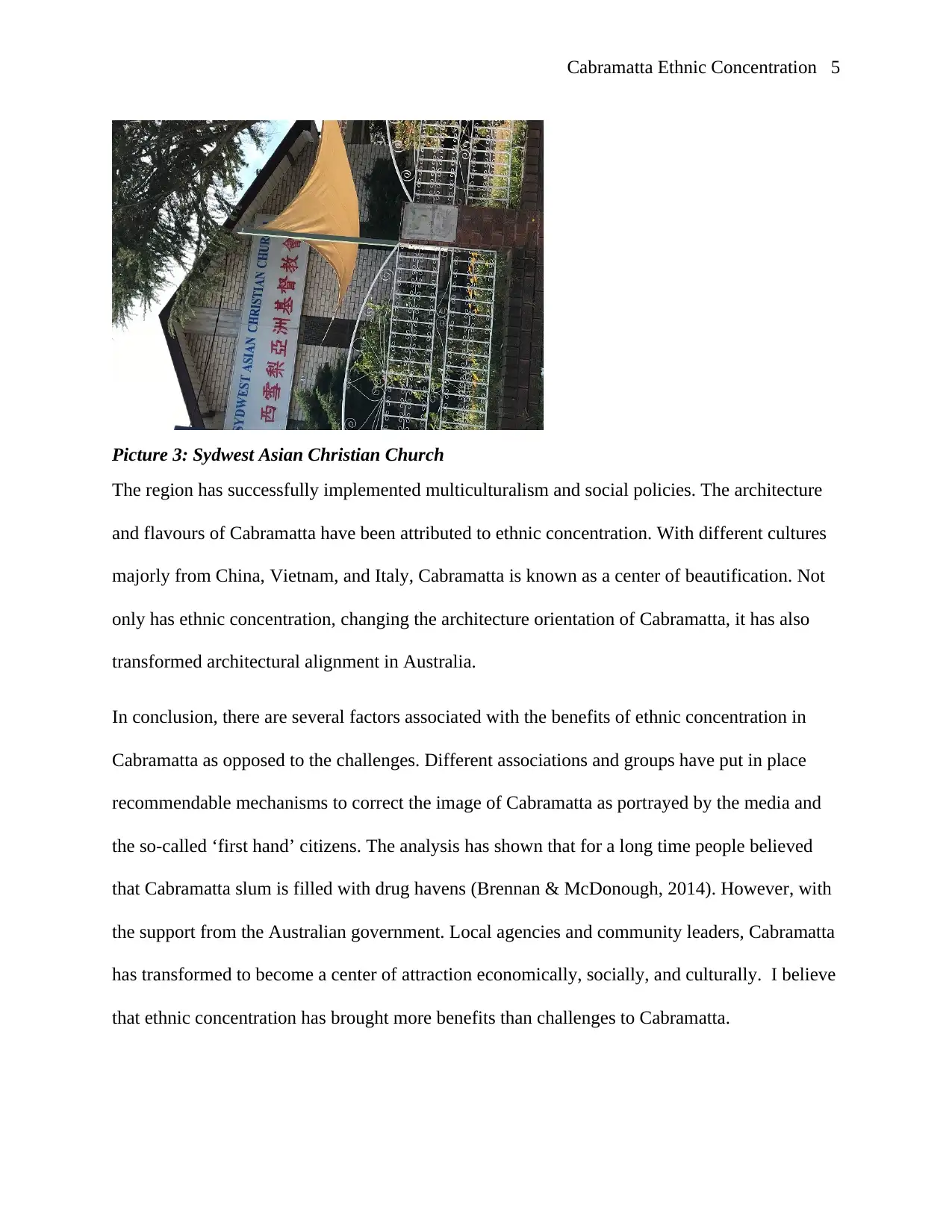
Cabramatta Ethnic Concentration 5
Picture 3: Sydwest Asian Christian Church
The region has successfully implemented multiculturalism and social policies. The architecture
and flavours of Cabramatta have been attributed to ethnic concentration. With different cultures
majorly from China, Vietnam, and Italy, Cabramatta is known as a center of beautification. Not
only has ethnic concentration, changing the architecture orientation of Cabramatta, it has also
transformed architectural alignment in Australia.
In conclusion, there are several factors associated with the benefits of ethnic concentration in
Cabramatta as opposed to the challenges. Different associations and groups have put in place
recommendable mechanisms to correct the image of Cabramatta as portrayed by the media and
the so-called ‘first hand’ citizens. The analysis has shown that for a long time people believed
that Cabramatta slum is filled with drug havens (Brennan & McDonough, 2014). However, with
the support from the Australian government. Local agencies and community leaders, Cabramatta
has transformed to become a center of attraction economically, socially, and culturally. I believe
that ethnic concentration has brought more benefits than challenges to Cabramatta.
Picture 3: Sydwest Asian Christian Church
The region has successfully implemented multiculturalism and social policies. The architecture
and flavours of Cabramatta have been attributed to ethnic concentration. With different cultures
majorly from China, Vietnam, and Italy, Cabramatta is known as a center of beautification. Not
only has ethnic concentration, changing the architecture orientation of Cabramatta, it has also
transformed architectural alignment in Australia.
In conclusion, there are several factors associated with the benefits of ethnic concentration in
Cabramatta as opposed to the challenges. Different associations and groups have put in place
recommendable mechanisms to correct the image of Cabramatta as portrayed by the media and
the so-called ‘first hand’ citizens. The analysis has shown that for a long time people believed
that Cabramatta slum is filled with drug havens (Brennan & McDonough, 2014). However, with
the support from the Australian government. Local agencies and community leaders, Cabramatta
has transformed to become a center of attraction economically, socially, and culturally. I believe
that ethnic concentration has brought more benefits than challenges to Cabramatta.
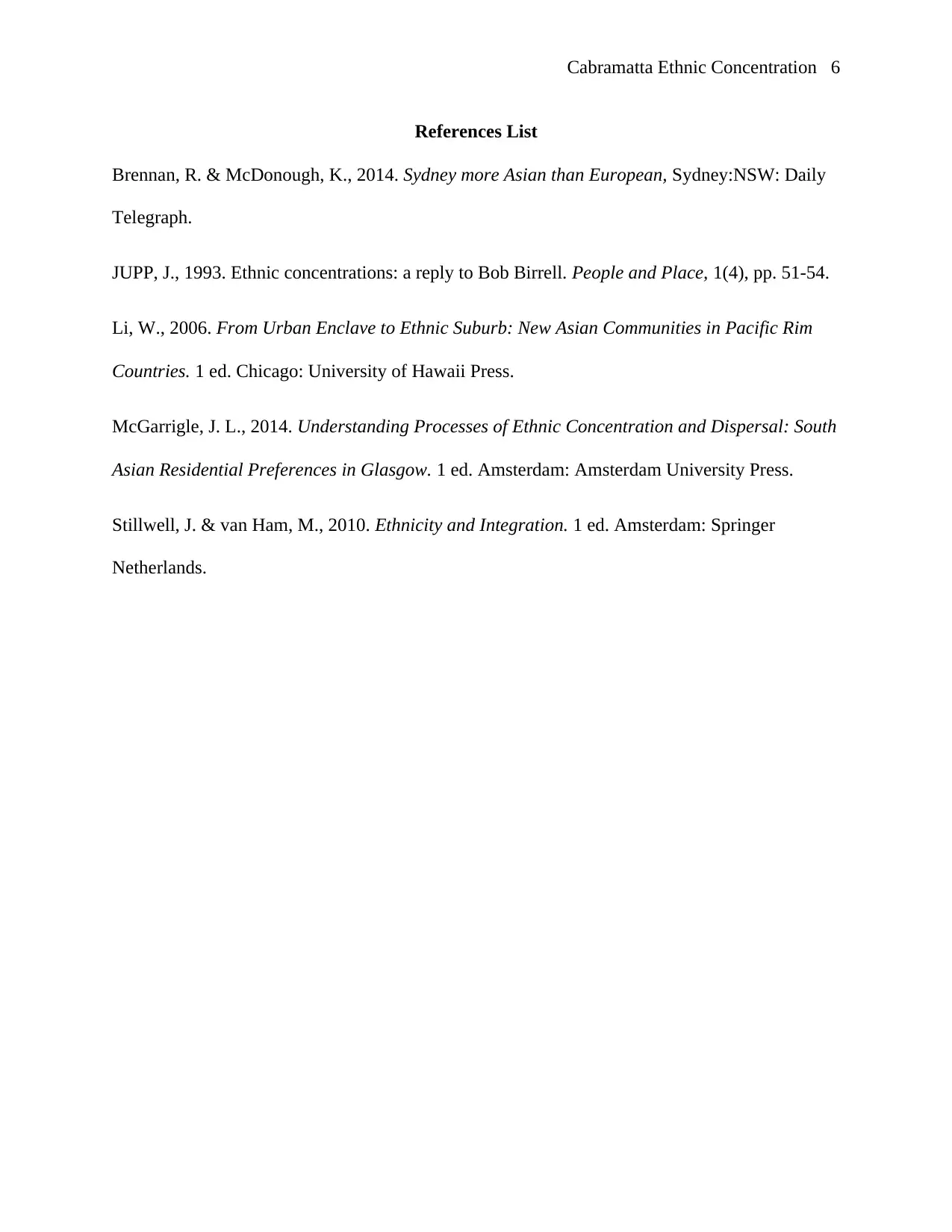
Cabramatta Ethnic Concentration 6
References List
Brennan, R. & McDonough, K., 2014. Sydney more Asian than European, Sydney:NSW: Daily
Telegraph.
JUPP, J., 1993. Ethnic concentrations: a reply to Bob Birrell. People and Place, 1(4), pp. 51-54.
Li, W., 2006. From Urban Enclave to Ethnic Suburb: New Asian Communities in Pacific Rim
Countries. 1 ed. Chicago: University of Hawaii Press.
McGarrigle, J. L., 2014. Understanding Processes of Ethnic Concentration and Dispersal: South
Asian Residential Preferences in Glasgow. 1 ed. Amsterdam: Amsterdam University Press.
Stillwell, J. & van Ham, M., 2010. Ethnicity and Integration. 1 ed. Amsterdam: Springer
Netherlands.
References List
Brennan, R. & McDonough, K., 2014. Sydney more Asian than European, Sydney:NSW: Daily
Telegraph.
JUPP, J., 1993. Ethnic concentrations: a reply to Bob Birrell. People and Place, 1(4), pp. 51-54.
Li, W., 2006. From Urban Enclave to Ethnic Suburb: New Asian Communities in Pacific Rim
Countries. 1 ed. Chicago: University of Hawaii Press.
McGarrigle, J. L., 2014. Understanding Processes of Ethnic Concentration and Dispersal: South
Asian Residential Preferences in Glasgow. 1 ed. Amsterdam: Amsterdam University Press.
Stillwell, J. & van Ham, M., 2010. Ethnicity and Integration. 1 ed. Amsterdam: Springer
Netherlands.
⊘ This is a preview!⊘
Do you want full access?
Subscribe today to unlock all pages.

Trusted by 1+ million students worldwide
1 out of 6
Related Documents
Your All-in-One AI-Powered Toolkit for Academic Success.
+13062052269
info@desklib.com
Available 24*7 on WhatsApp / Email
![[object Object]](/_next/static/media/star-bottom.7253800d.svg)
Unlock your academic potential
Copyright © 2020–2025 A2Z Services. All Rights Reserved. Developed and managed by ZUCOL.





